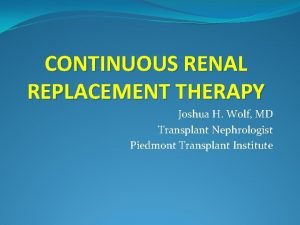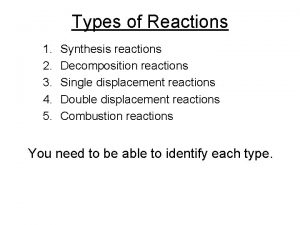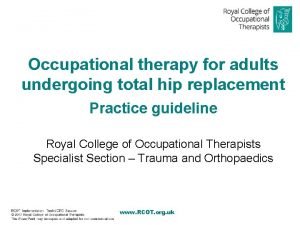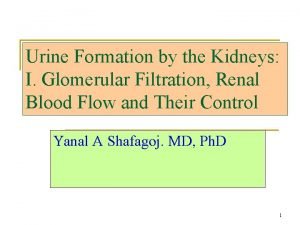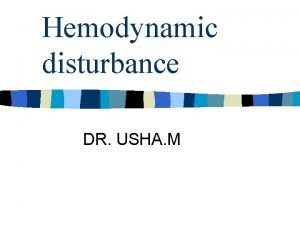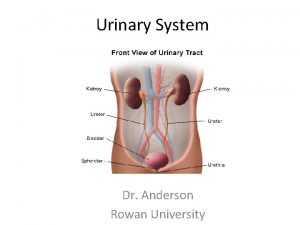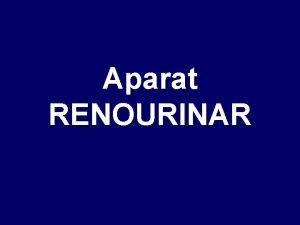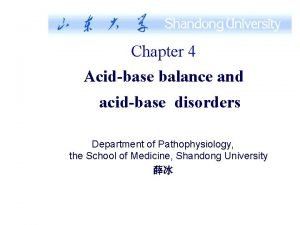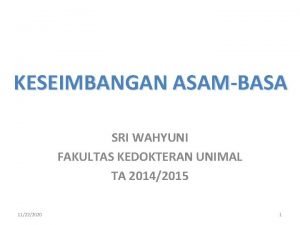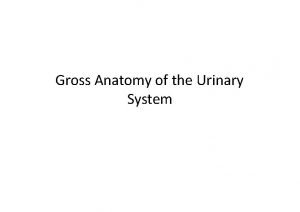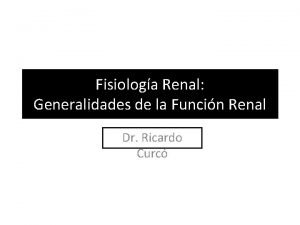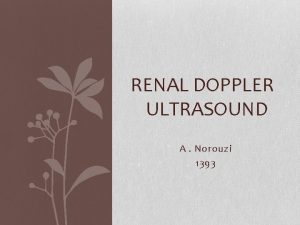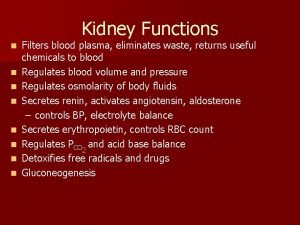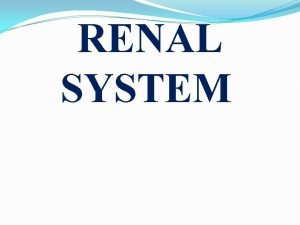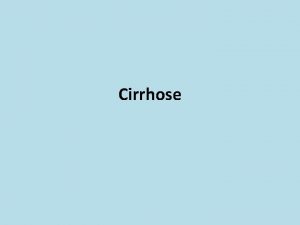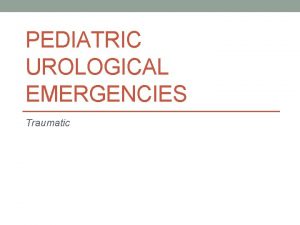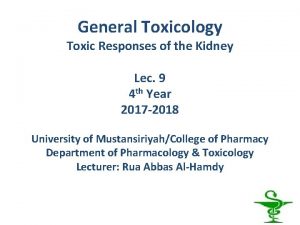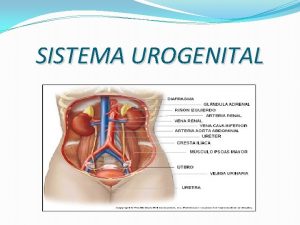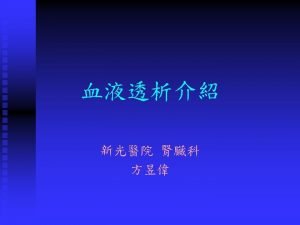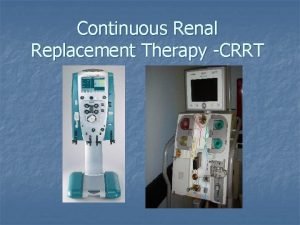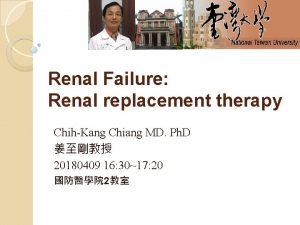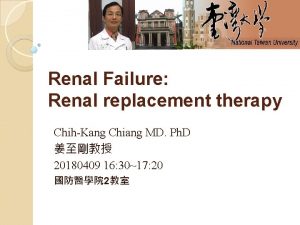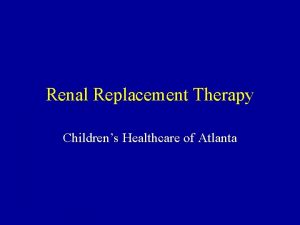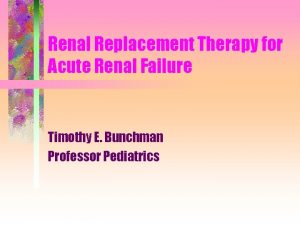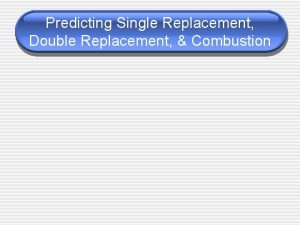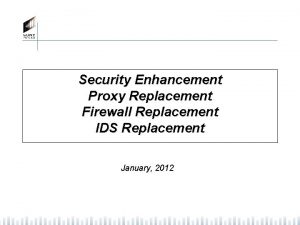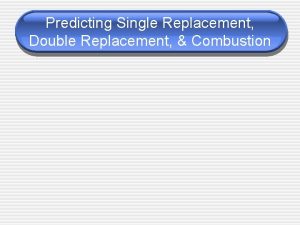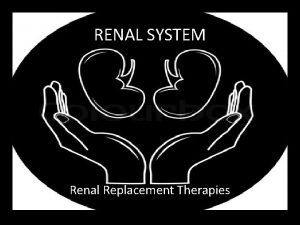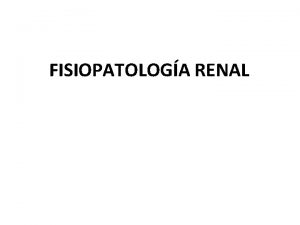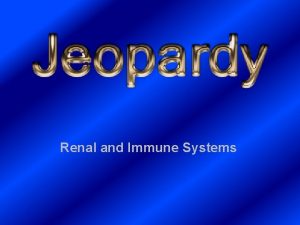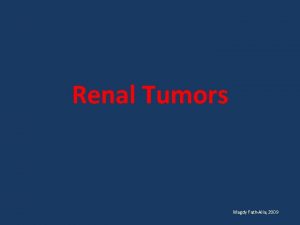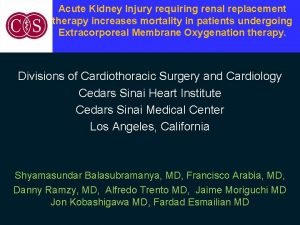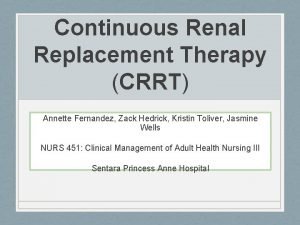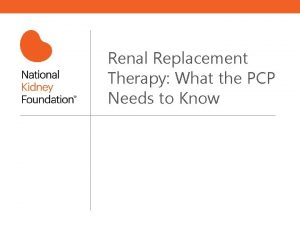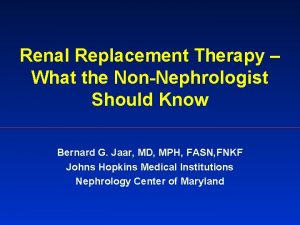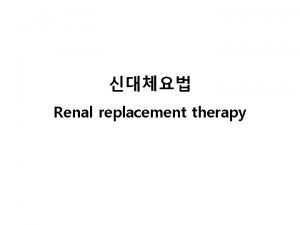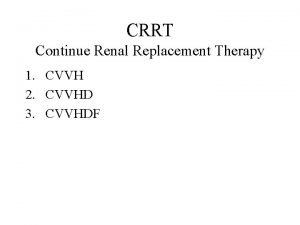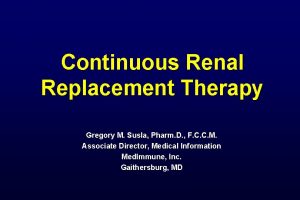Renal replacement therapy n HD n PD n






























- Slides: 30


Renal replacement therapy n 血液透析 (H/D) n 腹膜透析 (PD) n 慢性連續性腎臟替代療法(Slow continue renal replacement therapy): CVVH, CAVH, CVVHD, CAVHD, CVVHDF, CAVHDF n 12/1/2020 PICU Training Course Slide 2

1. 何時該介入腎臟替代療法? 2. 該如何選擇何種腎臟替代療法 ? H/D; P/D or CVVH; CVVHD 12/1/2020 PICU Training Course Slide 3

Indications for Acute Dialysis(1) 1. 2. 3. 4. 5. 6. Symptomatic fluid overload Hyperkalemia (K + ≧ 7. 0 m. Eq/L) m. Eq/L Symptomatic uremia and/or BUN >150 -175 mg/d. L Severe intractable acidosis (p. H ≦ 7. 1) Nonobstructive anuria Oliguria with rapid progression of renal insufficiency 7. Severe hyponatremia or hypernatremia 12/1/2020 PICU Training Course Slide 4

Indications for Acute Dialysis (2) Severe hyperphosphatemia and hypocalcemia 9. Inadequate urine output with obligatory IV fluid requirements 10. Potentially harmful levels of toxins. poisons. or drugs (hemodialysis or hemoperfusion) 11. Tumor lysis syndrome (uric acid >20 mg/d. L) mg/d. L 12. Hyperammonemia in inborn errors or in inborn errors metabolism (hemodialysis) 8. 12/1/2020 PICU Training Course Slide 5


Acute Peritoneal Dialysis in Children § PD is more efficient in infants and children Peritoneal surface area in children: twice than that of adult per kg body weight § The ultrafiltration rate per Kg BW: higher in smaller pediatric patients short dialysate dewell times are used n Pediatric hemodialysis: technical challenges and requires specially trained personnel 12/1/2020 PICU Training Course Slide 7

Technical Consideration of PD § Single (or Two) cuff Tenckhoff catheter Insertion: Surgical insertion or Percutaneous insertion § Insertion Site: 12/1/2020 PICU Training Course Slide 8

Tenckhoff PD catheter 12/1/2020 PICU Training Course Slide 9

Tenckhoff PD catheter-2 cuff 12/1/2020 PICU Training Course Slide 10

12/1/2020 PICU Training Course Slide 11

12/1/2020 PICU Training Course Slide 12

12/1/2020 PICU Training Course Slide 13

12/1/2020 PICU Training Course Slide 14

12/1/2020 PICU Training Course Slide 15

該如何開立腹膜透析處方 ? 12/1/2020 PICU Training Course Slide 16

Acute peritoneal dialysis order 1. 2. 3. 4. 5. 6. 7. 8. Dialysate solution %(1. 5%, 2. 5%4. 25%) Exchange volume: initial 20 ml/kg and gradually up to 40~50 ml/kg during one week Warm dialysate fluid to 37 ℃ ( 用 blood exchange 之溫血環) Cycle time: inflow 5~10 minutes dwell 30~40 minutes outflow 15~20 minutes Add heparin 500~1000 units/L of dialysate till dialysate celar Add K+ 4 meq/L of dialysate, if serum K+ < 4 meq/L Turn and position patient p. r. n. for optimum outflow. BUN/Cre, ABG, Na, K, Cl, and glucose qd at least 12/1/2020 PICU Training Course Slide 17

The Standard peritoneal dialysis solution formulation(m. Eq/L) Na: 132; K: 0; Mg: 0. 5; Ca: 3. 5; Cl: 96; Lactate: 40 Dextrose (glucose monohydrate): 1. 5%; 2. 5%; 4. 25% Package: 1 L(1. 5%); 2 L; 2. 5 L; 5 L/bag Dextrose Glucose Osmolarity g/d. L m. Osm/L m. L/exchange L/d 1. 5 1. 36 346 50 -150 1. 2 -3. 6 2. 5 2. 27 396 100 -300 2. 4 -7. 2 4. 25 3. 86 485 300 -400 7. 2 -9. 6 12/1/2020 Ultrafiltrate Volume PICU Training Course Slide 18

Notify Doctor immediately if: 1. 2. 3. 4. Poor dialysate flow or drainage Severe abdominal pain or distension Bright red blood or cloudy dialysate drainage Dialysate leak or purulent drainage around catheter exit site 5. Tachypneia or SOB 6. Fever 12/1/2020 PICU Training Course Slide 19

Complications of PD (1) n n n n n Bleeding from skin incision Intestinal perforation Bladder perforation Leakage of Dialysate Air under the diaphragm Hypokalemia Hyperglycemia Hernia and Hydrocele PD tube migration and obstruction 12/1/2020 PICU Training Course Slide 20

Complications of PD (2) n n n n Decreased ultrafiltration/Increasing fluid retention Increased ultrafiltration/Excessive fluid removal Hypotension Exit site infection Tunnel infection Peritonitis Pulmonary complications Protein loss and Nutritional deficiencies 12/1/2020 PICU Training Course Slide 21

Acute Hemodialysis (1) n n n Dual-lumen catheter insertion: femoral vein, subclavian vein, internal jugular vein Single catheter in umbilical vein with the other central venous catheter A blood-flow rate of at least 2 to 3 m. L/Kg/min The extracorporeal blood volume should not exceed 10% of the patient’s blood volume ( or approximately 8 ml/kg BW) Fluid removal should generally not exceed 5% of BW over 4 -6 hrs 12/1/2020 PICU Training Course Slide 22

Acute Hemodialysis(2) Blood flow rate(BFR): BFR=2. 5 x. BW(kg)+100 ml/min (p’t BW: 10 -40 kg) BFR<100 ml/min (p’t BW<10 kg) BFR=100~250 ml/min (p’t BW>40 kg) Urea clearance: <3 -5 ml/min/kg 12/1/2020 PICU Training Course Slide 23

Hemodialysis prescription n n n Dialyzer: dialyzer membrane; KUf; dialyzer efficiency Blood flow rate: 100~250 ml/mins Dialysis solution flow rate: 300~500 ml/mins Dialysis soultion Temp. : 35 -36℃ Anticoagulation: Heparin Session length: as patient’s condition 12/1/2020 PICU Training Course Slide 24

Dialysis solution composition n n Bicarbonate: 25 m. Eq/L Na: 145 (135 -145) m. Eq/L; K: 3. 5(2 -4) m. Eq/L Ca: 3. 5(2. 5 -3. 5) m. Eq/L; Mg: 0. 75(0. 75 -1. 5) m. Eq/L; P: none Dextrose: 200 mg/d. L 12/1/2020 PICU Training Course Slide 25

Complications during HD n Hypotension: n n n N/S bolus or 5%albumin; mannitol (0. 51. 0 g/kg); 25% albumin(0. 3 -0. 5 gm/kg) ↑ dialysate Na (140 m. Eq/L and higher) Ultrafiltration in the first hour and then dialysis Disequilibrium Syndrome Arrthymia 12/1/2020 PICU Training Course Slide 26

12/1/2020 PICU Training Course Slide 27


12/1/2020 PICU Training Course Slide 29

THE END 12/1/2020 PICU Training Course Slide 30
 Res extra commercium
Res extra commercium Diagnostico etiologico
Diagnostico etiologico Rrt aeiou
Rrt aeiou Distinguish between renal corpuscle and renal tubule
Distinguish between renal corpuscle and renal tubule Combustion reaction formula
Combustion reaction formula Occupational therapy intervention plan for hip arthroplasty
Occupational therapy intervention plan for hip arthroplasty 18004149025
18004149025 Major physiological anions
Major physiological anions Bioness bits cost
Bioness bits cost Psychoanalytic therapy is to as humanistic therapy is to
Psychoanalytic therapy is to as humanistic therapy is to Psychoanalytic therapy is to as humanistic therapy is to
Psychoanalytic therapy is to as humanistic therapy is to Capillary filtration coefficient
Capillary filtration coefficient Edema lesion
Edema lesion Renal tubule
Renal tubule Pacr uwe
Pacr uwe Calice renale
Calice renale Respiratory alkalosis renal compensation
Respiratory alkalosis renal compensation Tubuloglomerular feedback mechanism
Tubuloglomerular feedback mechanism Dapar
Dapar Renal tract
Renal tract First order kinetics
First order kinetics Depuracion de inulina
Depuracion de inulina Renal index
Renal index Renal columns
Renal columns Papillary renal cell carcinoma
Papillary renal cell carcinoma Renal system
Renal system Syndrome hepato renal
Syndrome hepato renal Renal cyst
Renal cyst Lec renal
Lec renal Corpusculo renal
Corpusculo renal Vildagliptin renal dose adjustment
Vildagliptin renal dose adjustment


